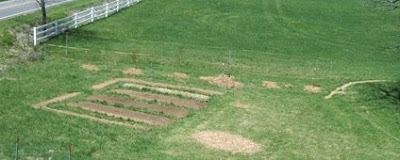Here is a recent view of the garden area showing the garden bed layout we used last year along with the row of fruit trees that we planted last week.

The layout consisted of 4 raised beds that were 4 feet wide wide by 16 feet long. These beds were used for annual vegetables with the exception of the far bed which is planted with strawberries, and garlics that were wintered over. Around the 4 raised beds was a concentric 2 foot wide raised bed that was used to plant beneficial flowers such as sunflowers and marigolds.
Since we have the space, we decided to mirror the configuration which will double the garden size. To carve new garden beds from the pasture, we use our BCS tiller in several passes. First we run it with a shallow depth setting for the tiller tines to break the sod apart. Then we run the tiller with the tines at the deepest setting to get a nice deep bed dug.

The picture above shows our BCS tiller. The BCS is a multi-purpose device called a walk-behind tractor. It consists of a tractor, which is the engine, transmission, and steering mechanisms, with a power take-off (PTO) attachment to which a multitude of implements, such as a rototiller can be operated. It is the same concept as a typical four-wheeled farm tractor which contains a three-point hitch and PTO for attaching and operating a wide variety of power implements. The walk-behind tractor is a much scaled down version of the same machinery in terms of size and cost. But it is the right size tool for most jobs on our 10 acre farm. I will try to dedicate a future post to the multi-purpose BCS.
The rototiller attachment for the BCS operates better than most dedicated rototillers. The tiller tines rotate at a higher rate than standard tillers, which provides more thorough tilling of the soil. After a couple passes with a shallow tine depth followed by a couple passes with a deeper tine depth, a swath of pasture sod is transformed into a beautiful loam.

Pasture sod is pretty thick and it takes a strong machine to transform the sod to garden soil. Just to show the strength of this tiller, here is what happened to a piece of rebar that was buried in the grass where I was trying to till.

Fortunately, the tines themselves are very tough as they did not appear to sustain any noticeable damage from this incident.
Once the beds were tilled, well rotted mule manure that has been composting over the winter was heaped onto the freshly tilled soil. We will leave the manure in place for a couple of weeks to allow it dry out somewhat and to allow the manure nutrients to fertilize the underlying soil. The composted manure has the consistency of clay, so attempting to till it into the soil until it has had a chance to dry would just clog up the tiller. Here is the manure pile before we started piling it onto the beds:

...and here is what was left after shoveling many, many wheelbarrow loads onto the new garden beds:

By amending the soil with such a significant amount of manure, the volume of the soil in the garden beds will obviously have to increase. Thus the end product will be raised beds of very rich soil. As the summer progresses we will have to provide some updates of how well the vegetables grow in these newly developed garden beds.


No comments:
Post a Comment